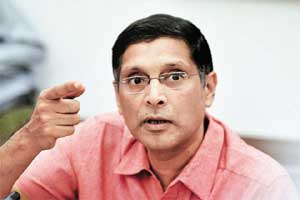The need to compensate states for any revenue loss from the goods and services tax (GST) would, if at all, be temporary as revenue would doubtless get a boost from the technology-enabled surge in compliance, chief economic adviser Arvind Subramanian said on Tuesday, arguing against keeping the standard GST rate high to find resources for the compensation. The money (for compensating states) would have to found from “elsewhere in the Budget”, he said.
Speaking at the Indian Express Group’s Idea Exchange programme, Subramanian, who had brought out a report in last December suggesting the revenue-neutral rate (15-15.5%) and standard rate (17-19%) for the proposed comprehensive indirect tax, based on certain assumption of the tax base (which largely holds true today) and the comparable tax rates prevailed in 2013-14, said that since the GST’s compliance benefit would be “huge” (“3-5 billion invoices would be automatically matched each month”), as one went along, the government could get the “same revenue from a reduced rate or a surfeit of revenue from the same rate”.
Asked whether the 2-3 percentage points increase in the rates of state VAT since its launch in 2005 negated the notion of rates of value-added taxes progressively coming down, he said unlike in the VAT regime where the states still enjoyed considerable discretion to keep exemptions, the mechanism of the GST Council, where decisions would be the Centre and states jointly and by defined consensus, would reduce the window of unilateral exemptions and exemptions per se. Also, he said, the relative slackening of the economic growth momentum in recent years must have played a role in VAT rate increases. Noticeably, most states’ own tax revenues have accelerated since the introduction of VAT, while the Centre’s tax revenue growth (which includes direct taxes), plateaued.
Subramanian iterated the stance that a moderate GST rate won’t be inflationary although more definitive assessment of the price impact of GST on specific commodities can be made only after the council decides the rates and the exemptions. While 54% of the items are now exempt from taxes, the bulk of these might be kept outside the GST ambit also. The bottom 40% of the populace would be “more protected (from price spike) given their consumption pattern and PDS benefits”.
On a day the Reserve Bank of India in its third bimonthly monetary policy statement, 2016-17, said “risks to the inflation target of 5% for March 2017 continue to be on the upside”, Subramanian presented a more benign outlook. The wage increases for government staff had already been accounted for (fiscal deficit won’t widen) and as far as their (increased) house rent allowances are concerned, they are too small to be able to stoke inflation, he said. Besides, the good monsoon will bring down food prices that largely explained a recent spurt in inflation.
The RBI, which had kept the interest rates unchanged earlier in the day said: “…while the direct statistical effect of house rent allowances under the 7th Central Pay Commission’s award may be looked through, its impact on inflation expectations will have to be carefully monitored so as to pre-empt a generalisation of inflation pressures. In terms of immediate outcomes, much will depend on the benign effects of the monsoon on food prices.”
On the inflation target of 4% plus or minus 2% fixed by the government and RBI for the period till April 2021, the CEA said the target was in line with India’s historical consensus on inflation tolerance. Stating that the period between 2007-06 and 2013-14 which saw inflation unconventionally high was an aberration, he said the target range fixed won’t require depressing farm prices.
The range allowed farm goods prices to be 4-5%, which would sustain reasonable growth in rural income.


